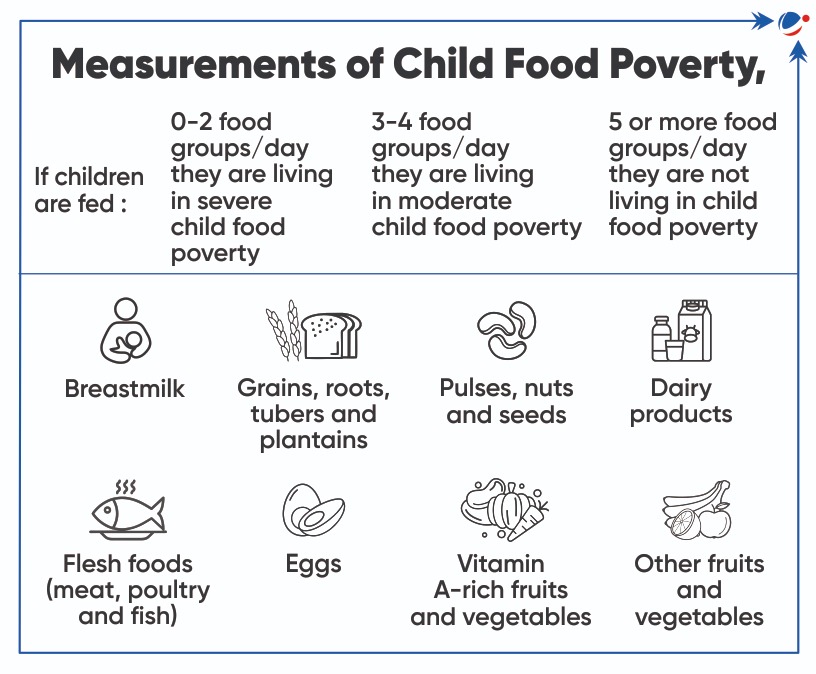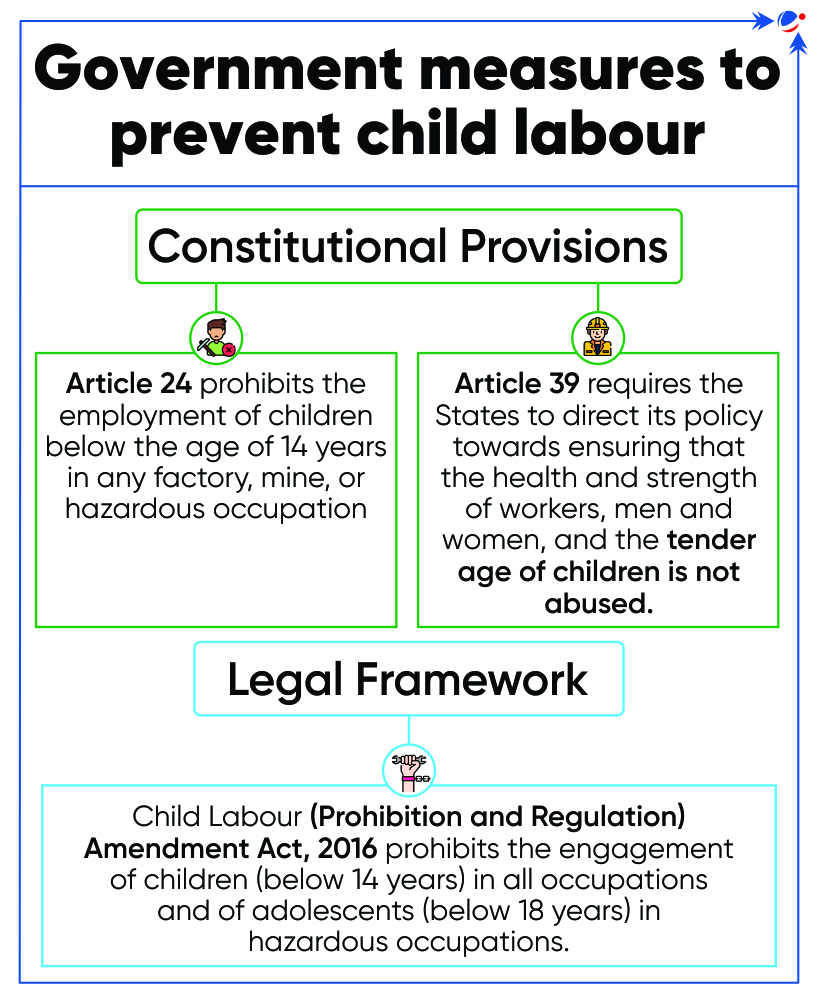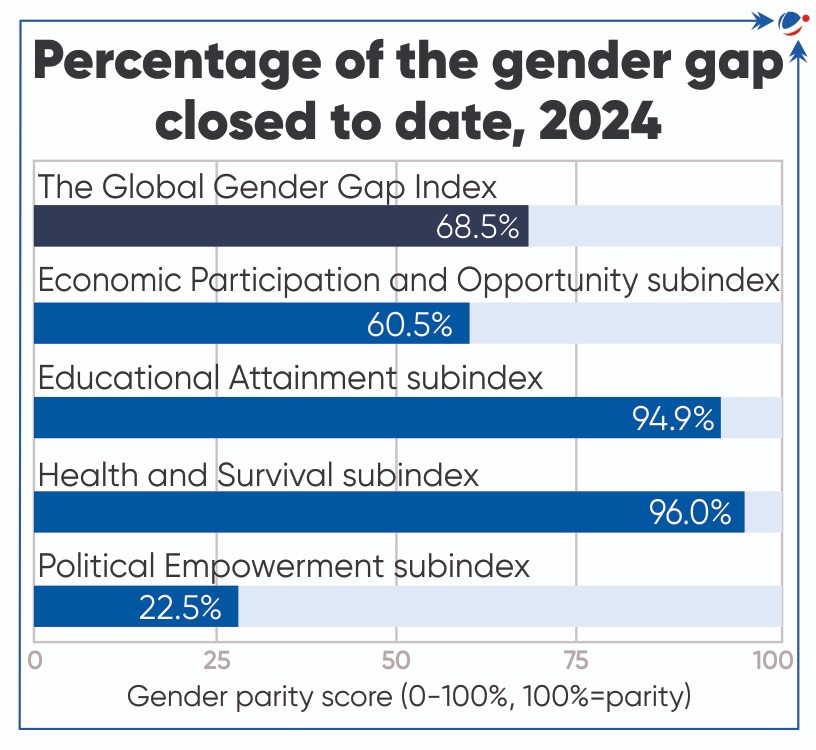UNICEF releases “Child Nutrition Report, 2024”
The report reveals severe child food poverty (CFP), defined as children’s inability to access and consume a nutritious and diverse diet in early childhood (first five years of life), globally.
Key findings
- Prevalence: ~27%children live in severe CFP, globally.
- In India, 40% of children suffer from severe CFP (2nd highest burden in South Asia after Afghanistan).
- Poor Diet: Unhealthy foods are becoming entrenched in children’s diets replacing nutrient-rich foods.
- Income and CFP: Severe CFP affects children in both poor and non-poor households, indicating income is not the only driving factor.
- Causes: Growing inequities, conflict and climate crises, combined with rising food prices, the overabundance of unhealthy foods, harmful food marketing strategies and poor child-feeding practices.
Recommendations
- Strengthen data systems to assess the severity of CFP.
- Transform food systems to make nutritious foods accessible, affordable and desirable option for feeding young children.
- Leverage health systems to deliver essential nutrition services, including counselling on child feeding.
India’s initiative
- Saksham Anganwadi and Poshan 2.0 focuses on maternal nutrition, infant and young child feeding norms, etc.
- Introducing millets in Mid-Day Meal Scheme (renamed as ‘PM Poshan’ scheme).
Measurement of CFPTo meet the minimum dietary diversity for healthy growth and development, children need to consume foods from at least five out of the eight defined groups.  |
- Tags :
- UNICEF
- Child food poverty (CFP)
Child Labour
- Twenty fifth anniversary of International Labour Organisation (ILO) convention No. 182 was observed recently.
- Convention No. 182 deals with “worst forms of child labour” and is the first ILO Convention to be universally ratified.
- India ratified it in 2017 along with convention No. 138 which deals with minimum age of employment.
Prevalence of Child Labour in India
- As per census 2011, 10.1 million children (3.9% of total child population) are working, either as ‘main worker’ or as ‘marginal worker’.
- Uttar Pradesh, Bihar, Rajasthan, Maharashtra, and Madhya Pradesh constitute nearly 55% of total working children in India.
- Child labour mostly persists in agriculture, household industries, roadside dabas, etc.
Reasons for Child Labour in India
- Poverty forces families to rely on their children’s labour to make their ends meet.
- Lack of quality education increases the likelihood of children entering the workforce prematurely.
- Disasters, conflicts and mass migration lead to economic instability and disrupt families exposing children to labour.
- Demand for Cheap Labour in various industries such as agriculture, domestic work.
- Lack of stringent legislation and enforcement of laws.

- Tags :
- International Labour Organisation (ILO)
- Child Labour in India
Global Food Policy Report 2024
The report, released by International Food Policy Research Institute (IFPRI), is themed around ‘food systems for healthy diets and nutrition’.
- Key findings
- Climate change and biodiversity loss can have complex and interconnected effects on diets, affecting food availability, diversity etc.
- More than two billion people, many of them in Africa and South Asia, cannot afford a healthy diet.
- Around 38 percent of the Indian population ate unhealthy foods
- As a result of poor diet, 16.6% Indians suffer from malnutrition (2021).
- About IFPRI: Established in 1975, it is a research center of the Consortium of International Agricultural Research Centers.
- Tags :
- International Food Policy Research Institute (IFPRI)
Migration and Development Brief 2024
The brief was released by the World Bank.
Key highlights
Remittance
- Remittance flows to low- and middle-income countries (LMICs) reached to $656 billion.
- Top five recipient countries: India ($120 billion), followed by Mexico, China, Philippines, and Pakistan.
Migration
- Top destinations Countries: US, Germany, Saudi Arabia, Russia, and UK.
- Largest origin countries: (18.7 million emigrants) followed by Ukraine, China, Mexico and Venezuela.
- Largest migration corridor: Mexico to US.
- Tags :
- World Bank




